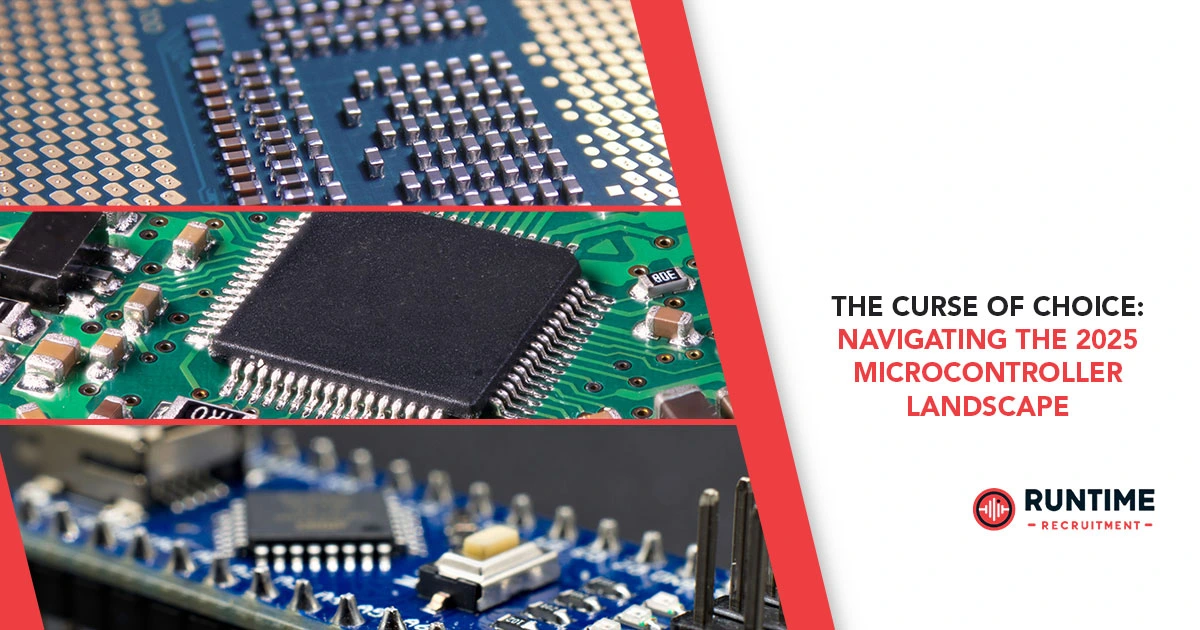For the embedded engineer, 2025 presents a paradoxical challenge: an unprecedented abundance of choice. What was once a relatively straightforward decision – 8-bit, 16-bit, or 32-bit? – has morphed into a sprawling, multi-dimensional matrix of architectures, peripherals, power profiles, security features, and AI capabilities. This “curse of choice” can be paralyzing, yet understanding its nuances is paramount for designing competitive, future-proof embedded systems.
The microcontroller (MCU) market is projected to continue its rapid ascent, fueled by the relentless march of IoT, the electrification of the automotive industry, and the increasing integration of artificial intelligence at the edge. Reports indicate the market size, valued at over $23 billion in 2024, is forecast to register an annual growth rate (CAGR) of 12.3% to reach $71.3 billion by 2034. This explosive growth means more innovation, more specialized silicon, and ultimately, more decisions for you, the embedded engineer.
The Shifting Sands of Architecture: ARM, RISC-V, and Beyond
For decades, ARM Cortex-M microcontrollers have been the undisputed champions of the embedded world, offering a robust ecosystem, extensive toolchains, and a vast array of silicon partners. In 2025, the Cortex-M series, particularly the M33 with TrustZone, continues to dominate in low-power IoT applications, secure medical monitoring, and industrial sensing. Companies like Nordic Semiconductor with their nRF54 series, and STMicroelectronics with the STM32U5 series, are pushing the boundaries of ultra-low power consumption and integrated security, often incorporating hardware cryptographic engines and secure boot mechanisms.
However, a formidable challenger has risen from the academic realm to the forefront of industry: RISC-V. This open-source instruction set architecture (ISA) has gained significant traction due to its royalty-free nature, customizability, and growing ecosystem. In 2025, RISC-V is no longer just a niche player; it’s a serious contender across various market segments, particularly in IoT devices and edge computing. Major players like Espressif Systems are already demonstrating the power of RISC-V with their ESP32-C6 and ESP32-S3 series, offering Wi-Fi 6, Bluetooth LE, Zigbee, and even AI capabilities for face and gesture detection. Infineon, a traditionally strong ARM proponent, is also actively collaborating with ecosystem partners to accelerate the adoption and maturity of RISC-V-based solutions, especially for automotive microcontrollers.
The proliferation of RISC-V introduces a fundamental architectural choice. Do you stick with the proven, feature-rich ARM ecosystem, leveraging its vast existing knowledge base and debugging tools, or do you embrace the flexibility and long-term cost advantages of RISC-V, with its burgeoning open-source community and freedom from vendor lock-in? This isn’t a simple “either/or” question; the optimal choice will depend heavily on your specific project requirements, development team expertise, and long-term strategic goals.
While ARM and RISC-V are the primary contenders in 2025, legacy architectures like Microchip’s PIC and Atmel’s AVR still hold their ground in specific applications, particularly where cost-effectiveness and proven simplicity are paramount. PIC microcontrollers, for instance, are noted for their rich peripheral sets and cost-effectiveness, making them suitable for industrial applications. AVRs, with their RISC architecture, offer fast execution and low power consumption, appealing to battery-operated devices. Understanding the diminishing, yet still relevant, roles of these architectures is part of navigating the complex 2025 landscape.
The AI Imperative: Bringing Intelligence to the Edge
Perhaps the most transformative trend shaping the 2025 microcontroller landscape is the pervasive integration of Artificial Intelligence (AI) and Machine Learning (ML) at the edge. The days of AI being confined to data centers are over; neural processing units (NPUs) and specialized AI accelerators are becoming as fundamental to chip design as traditional CPUs.
Microcontroller manufacturers are actively embedding AI algorithms directly into devices, enabling real-time processing, reduced latency, enhanced security, and lower operational costs. For instance, the Nordic nRF54H20 adds edge AI acceleration for audio and gesture recognition, while STMicroelectronics’ STM32U5 series supports AI via STM32Cube.AI and Edge Impulse integration. Renesas recently introduced the RZ/V2N AI MPU, designed to handle real-time AI workloads like image processing and video encoding with remarkable power efficiency, achieving 10 TOPS per watt without the need for bulky heat sinks.
This shift means embedded engineers must now consider not just raw processing power but also the efficiency of AI inference, the availability of optimized AI frameworks (like TensorFlow Lite Micro), and the ease of deploying and updating ML models on the MCU. The choice of an MCU is increasingly tied to its “AI readiness” – its ability to efficiently execute AI workloads directly on the device, minimizing reliance on cloud connectivity and enhancing privacy.
Security and Connectivity: Non-Negotiable Pillars
As embedded systems become increasingly interconnected, cybersecurity is no longer an afterthought but a foundational design principle. In 2025, regulatory frameworks are tightening, and the demand for robust security measures, including secure boot processes, cryptographic engines, and active tamper detection, is at an all-time high. The EU’s Cyber Resilience Act and the U.S. Cyber Trust Mark are driving compliance, pushing manufacturers to integrate advanced security features into their MCUs.
Many modern MCUs, such as those in the NXP MCX L series and the STMicroelectronics STM32U5 series, incorporate hardware-backed security features like TrustZone technology, secure provisioning tools, and hardware-accelerated cryptographic functions. The separation of power domains in some architectures also enhances security by enabling software isolation between tasks. For the embedded engineer, selecting an MCU means thoroughly vetting its security capabilities, understanding its compliance certifications, and ensuring it can withstand evolving cyber threats.
Concurrently, wireless connectivity continues to be a critical differentiator. Bluetooth LE, Wi-Fi 6, Zigbee, and Thread are becoming standard integrations, enabling seamless communication between devices and with the cloud. The challenge lies in selecting an MCU that not only supports the required wireless protocols but also offers robust RF performance, low power consumption for connected modes, and a mature software stack for easy integration. The rise of Matter, a universal open-source connectivity standard for smart home devices, further complicates the connectivity landscape, requiring MCUs that are “Matter-ready.”
Power Management and Energy Efficiency: The Green Imperative
With the global emphasis on sustainability, energy efficiency has become a non-negotiable requirement for embedded systems, particularly in battery-dependent IoT applications. In 2025, developers are focusing on optimizing power consumption through advanced low-power modes, dynamic voltage scaling, and energy-efficient architectures.
Leading MCUs are designed for ultra-low active current consumption (e.g., Nordic’s nRF54 series with ~50 µA/MHz) and deep sleep modes that consume mere nanoamperes (e.g., STM32U5 series at ~300 nA, Ambiq Apollo4 Blue Plus at 20 nA). NXP’s MCX L series, for instance, implements a dual power domain architecture, separating real-time and low-power sensing operations to achieve exceptional energy efficiency, with its Cortex-M0+ core consuming just 14 µA in active mode for continuous sensing tasks.
Evaluating power profiles goes beyond simply looking at datasheet numbers; it involves understanding wake-up latencies, the efficiency of integrated power management units, and the practical current consumption across various operating modes for your specific application. The wrong choice here can significantly impact battery life, thermal management, and overall system cost.
Ecosystem, Toolchains, and Supply Chain: The Practical Realities
Beyond the silicon itself, the ecosystem surrounding an MCU is arguably just as critical. A powerful MCU is useless without a comprehensive development environment. In 2025, engineers prioritize:
- SDKs and RTOS Support: Mature Software Development Kits (SDKs) and robust Real-Time Operating Systems (RTOS) like Zephyr, FreeRTOS, and Azure RTOS are essential for efficient development.
- IDE Support and Debugging Tools: A well-integrated Integrated Development Environment (IDE) with powerful debugging capabilities is crucial for shortening development cycles.
- Documentation and Community Support: Comprehensive documentation, application notes, and an active community forum can significantly streamline problem-solving.
- AI/ML Readiness: This includes not just hardware accelerators but also readily available inference frameworks (e.g., TensorFlow Lite Micro, Edge Impulse integration) and optimized libraries.
- Long-Term Availability and Supply Chain Resilience: The lessons of recent years have underscored the importance of selecting MCUs with reliable supply chains and clear long-term availability roadmaps. Vendors that prioritize stable production and offer multiple manufacturing sites are increasingly favored.
The choice between a proprietary ecosystem (like STMicroelectronics’ STM32Cube or NXP’s MCUXpresso) and a more open-source approach (often seen with RISC-V and its embrace of tools like Zephyr RTOS) introduces another layer of complexity. While proprietary tools can offer highly optimized performance, open-source alternatives provide flexibility and community-driven innovation.
Navigating the Maze: A Checklist for the Modern Embedded Engineer
Given the “curse of choice,” how does an embedded engineer make an informed decision in 2025? Here’s a practical checklist to guide your selection process:
- Define Your Requirements Meticulously:
- Core Functionality: What are the essential tasks the MCU needs to perform?
- Processing Power: What are the MIPS/MHz requirements? Do you need a single core or multi-core?
- Memory: How much Flash and RAM is needed (and is it embedded or external)?
- Peripherals: List every required peripheral (UART, SPI, I2C, ADC, DAC, Timers, PWM, USB, Ethernet, etc.).
- Power Budget: What are the active, sleep, and deep-sleep current consumption targets? What are the wake-up latencies?
- Connectivity: Which wireless protocols are essential (BLE, Wi-Fi, Zigbee, Thread, cellular)? Is Matter compliance needed?
- Security: What level of security is required (secure boot, hardware crypto, TrustZone, tamper detection)? What regulatory compliance is necessary?
- AI/ML: Are edge AI capabilities needed? What kind of inference (audio, vision, sensor fusion)? Which frameworks are preferred?
- Form Factor and Package: What are the physical constraints of your design?
- Cost: What is the target Bill of Material (BOM) cost?
- Evaluate Architectures Based on Project Philosophy:
- ARM Cortex-M: Mature ecosystem, vast tooling, broad vendor support, excellent for power-sensitive applications.
- RISC-V: Open, flexible, royalty-free, growing community, strong for customization and future-proofing, especially for new designs.
- Legacy (PIC/AVR): Consider for extremely low-cost, single-function, simple applications where existing expertise is high.
- Prioritize Ecosystem and Toolchain Support:
- SDK Maturity: How complete and well-documented is the SDK?
- RTOS Integration: Is your preferred RTOS well-supported?
- IDE and Debugging: Are the development tools robust and user-friendly?
- AI Toolchain: Are there integrated tools for model conversion, optimization, and deployment to the MCU?
- Community and Support: How active is the community? What level of vendor support is available?
- Assess Supply Chain Reliability and Longevity:
- Vendor Reputation: Does the vendor have a strong track record of supply chain management?
- Long-Term Commitment: Is the chosen MCU family expected to be available for the foreseeable future?
- Alternative Sources: Are there pin-compatible or software-compatible alternatives in case of supply issues?
- Prototype and Test Rigorously:
- Development Kits: Leverage readily available development boards to rapidly prototype and test your critical functionalities.
- Real-World Performance: Don’t rely solely on datasheets; measure actual power consumption, processing speed, and peripheral performance in your application context.
The “curse of choice” is indeed a formidable challenge, but it also represents an unparalleled opportunity. The sheer variety and specialization of 2025 microcontrollers mean that, with careful consideration and rigorous evaluation, you can find the perfect silicon heart for your next groundbreaking embedded product.
Ready to Navigate the Future of Embedded Systems?
The microcontroller landscape of 2025 demands engineers who are not just technically proficient but also strategic thinkers, capable of making informed decisions amidst a sea of options.
If you’re an embedded engineer looking for your next challenge, or a company seeking top-tier embedded talent, the right partner can make all the difference.Connect with RunTime Recruitment today. We are engineers turned recruiters, deeply understanding the nuances of embedded systems, firmware, IoT, and AI-driven hardware. Let us leverage our precision matching and industry expertise to help you find your ideal role or the perfect addition to your team.









